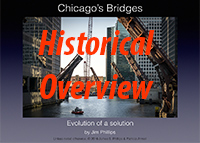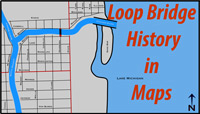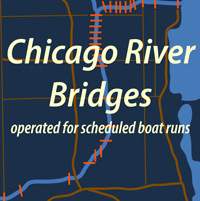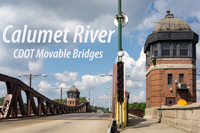Check out maps showing bridge locations over the years
Chicago started its life as a busy port on the water route from Buffalo, NY to the Mississippi River and beyond. It was important for this growing city to balance the need to cross its river with the need for vessels to navigate it. Movable bridges were the key to these competing needs. The first bridges built between 1840 and 1854 were floating swing bridges. These bridges were cumbersome to move and were vulnerable during flooding.
The next generation of movable bridges was the center pier swing bridges. These bridges were built between 1854 and 1890. These bridges were relatively quick to open. As vessels grew in size, the center pier in the middle of the river interfered with navigation. An example is shown below in the 1866 lithograph of the Lake Street Bridge.

Lithograph in James W. Sheahan, Chicago Illustrated (Chicago: Jevne & Almini, 1866). P&P,LC-USZ62-23805. (Library of Congress Digital image provided in BRIDGES by Richard Cleary, copyright 2007, W. W. Norton & Company.)
Bascule bridges were the ultimate design solution to Chicago's movable bridge problem. This type of bridge is relatively quick to open and provides a wide channel for navigation. Two types of bascule bridges were initially used.
The first was the rolling lift bridge (designed by William Scherzer and patented by Albert Scherzer), where the bridge leaf rolled horizontally on tracks as it raised vertically. This design had some disadvantages. Early bridges built in Chicago had inadequate foundations and the bridge tracks deteriorated faster than expected. Probably the biggest disadvantage was the royalties that had to be paid to the design patent holders. The drawing below shows the 1903 Scherzer rolling lift bridge built at W. Randolph St. This bridge was replaced by the current bridge in 1984 - drawing Courtesy of the Chicago Department of Transportation, Division of Engineering.

The second was the trunnion bascule bridge, where the bridge deck rotated upward on an axle. In an effort to avoid royalty fees on patented bridge components, Chicago engineers modeled their fixed trunnion bridge after the 1894 Tower Bridge of London. The drawing below shows the W. Washington Blvd. bridge built in 1913 - drawing Courtesy of the Chicago Department of Transportation, Division of Engineering.

Sixteen of these bridges are Chicago Type, Trunnion Bascule Bridges. The bridges at Jackson Blvd and Lake Shore Dr were built by the Strauss Bascule Bridge Co and technically not Chicago Type bridges, though the differences are minor.










